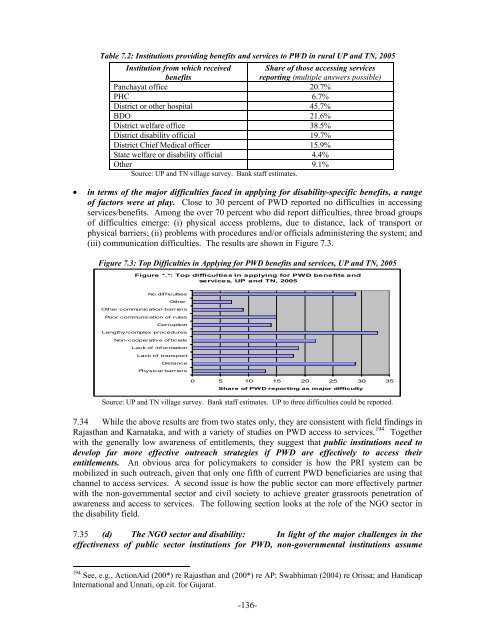People with Disabilities in India: From Commitment to Outcomes
People with Disabilities in India: From Commitment to Outcomes
People with Disabilities in India: From Commitment to Outcomes
Create successful ePaper yourself
Turn your PDF publications into a flip-book with our unique Google optimized e-Paper software.
Table 7.2: Institutions provid<strong>in</strong>g benefits and services <strong>to</strong> PWD <strong>in</strong> rural UP and TN, 2005<br />
Institution from which received<br />
benefits<br />
Share of those access<strong>in</strong>g services<br />
report<strong>in</strong>g (multiple answers possible)<br />
Panchayat office 20.7%<br />
PHC 6.7%<br />
District or other hospital 45.7%<br />
BDO 21.6%<br />
District welfare office 38.5%<br />
District disability official 19.7%<br />
District Chief Medical officer 15.9%<br />
State welfare or disability official 4.4%<br />
Other 9.1%<br />
Source: UP and TN village survey. Bank staff estimates.<br />
• <strong>in</strong> terms of the major difficulties faced <strong>in</strong> apply<strong>in</strong>g for disability-specific benefits, a range<br />
of fac<strong>to</strong>rs were at play. Close <strong>to</strong> 30 percent of PWD reported no difficulties <strong>in</strong> access<strong>in</strong>g<br />
services/benefits. Among the over 70 percent who did report difficulties, three broad groups<br />
of difficulties emerge: (i) physical access problems, due <strong>to</strong> distance, lack of transport or<br />
physical barriers; (ii) problems <strong>with</strong> procedures and/or officials adm<strong>in</strong>ister<strong>in</strong>g the system; and<br />
(iii) communication difficulties. The results are shown <strong>in</strong> Figure 7.3.<br />
Figure 7.3: Top Difficulties <strong>in</strong> Apply<strong>in</strong>g for PWD benefits and services, UP and TN, 2005<br />
Figure *.*: Top difficulties <strong>in</strong> apply<strong>in</strong>g for PWD benefits and<br />
services, UP and TN, 2005<br />
No difficulties<br />
Other<br />
Other communication barriers<br />
Poor communication of rules<br />
Corruption<br />
Lengthy/complex procedures<br />
Non-cooperative officials<br />
Lack of <strong>in</strong>formation<br />
Lack of transport<br />
Distance<br />
Physical barriers<br />
0 5 10 15 20 25 30 35<br />
Share of PWD report<strong>in</strong>g as major difficulty<br />
Source: UP and TN village survey. Bank staff estimates. UP <strong>to</strong> three difficulties could be reported.<br />
7.34 While the above results are from two states only, they are consistent <strong>with</strong> field f<strong>in</strong>d<strong>in</strong>gs <strong>in</strong><br />
Rajasthan and Karnataka, and <strong>with</strong> a variety of studies on PWD access <strong>to</strong> services. 194 Together<br />
<strong>with</strong> the generally low awareness of entitlements, they suggest that public <strong>in</strong>stitutions need <strong>to</strong><br />
develop far more effective outreach strategies if PWD are effectively <strong>to</strong> access their<br />
entitlements. An obvious area for policymakers <strong>to</strong> consider is how the PRI system can be<br />
mobilized <strong>in</strong> such outreach, given that only one fifth of current PWD beneficiaries are us<strong>in</strong>g that<br />
channel <strong>to</strong> access services. A second issue is how the public sec<strong>to</strong>r can more effectively partner<br />
<strong>with</strong> the non-governmental sec<strong>to</strong>r and civil society <strong>to</strong> achieve greater grassroots penetration of<br />
awareness and access <strong>to</strong> services. The follow<strong>in</strong>g section looks at the role of the NGO sec<strong>to</strong>r <strong>in</strong><br />
the disability field.<br />
7.35 (d) The NGO sec<strong>to</strong>r and disability: In light of the major challenges <strong>in</strong> the<br />
effectiveness of public sec<strong>to</strong>r <strong>in</strong>stitutions for PWD, non-governmental <strong>in</strong>stitutions assume<br />
194 See, e.g., ActionAid (200*) re Rajasthan and (200*) re AP; Swabhiman (2004) re Orissa; and Handicap<br />
International and Unnati, op.cit. for Gujarat.<br />
-136-










